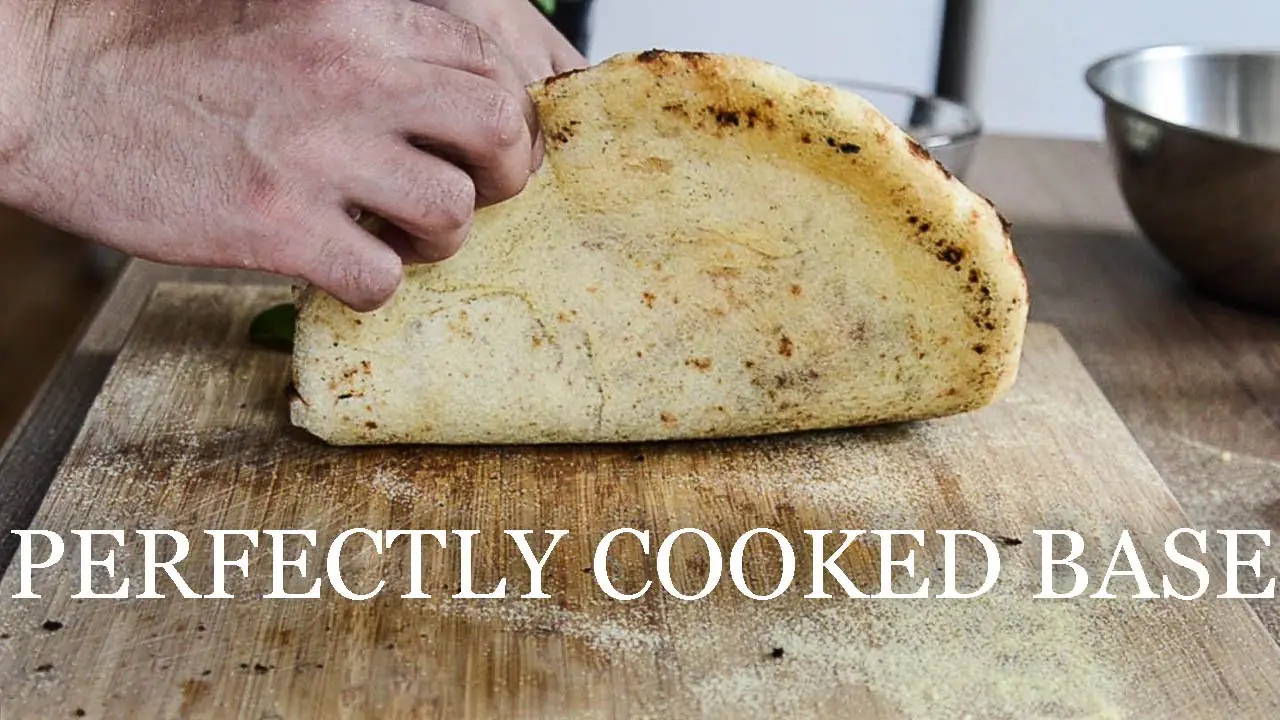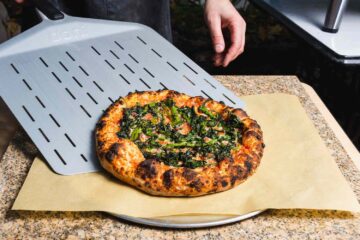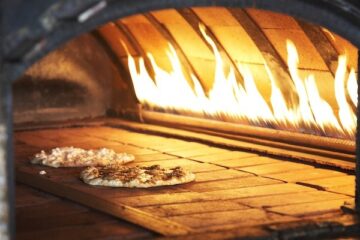To prevent the bottom of your pizza from burning in a pizza oven, use indirect heat and close the lid to trap as much heat as possible. Avoid using excess flour under the dough and make sure to toss the pizza properly while stretching.
Additionally, consider using a perforated pizza pan or pizza stone to allow for better airflow and prevent burning. Rotating the pizza without moving it around on the hearth can also help maintain an even cook. If you follow these guidelines, your pizza won’t burn on the bottom.
Reasons For Bottom Of Pizza Burning
The bottom of your pizza may burn due to temperature, time, dough ingredients, excess flour, and cold pizza dough. To prevent this, use indirect heat and close the lid to trap as much heat as possible. Avoid using too much flour under the dough, and properly stretch and toss the pizza.
The last thing you want is a burnt crust when making a delicious pizza. There are several reasons why the bottom of your pizza may be burning in the pizza oven. Let’s take a closer look at some of the common factors that can lead to this issue:
Temperature And Time:
- High temperature: One of the main reasons for a burnt bottom is a high oven temperature. If the heat is too intense, it can quickly brown and even scorch the bottom of the pizza.
- Long baking time: Leaving the pizza in the oven for too long can also cause the bottom to burn. Finding the right balance between cooking the toppings and ensuring the crust doesn’t get overcooked is essential.
Ingredients In The Dough:
- Sugar content: Excess sugar in the dough can cause it to brown faster and contribute to burning the bottom.
- Oil or fat: Too much oil or fat in the dough can make the crust more prone to burning.
Excess Flour:
- Flour buildup: Sprinkling too much flour on the pizza peel or using excessive flour in the dough can lead to a buildup on the bottom of the pizza. This extra flour can burn and create a charred taste.
Use Of Cold Pizza Dough:
- Cold dough: If you’re using cold pizza dough straight from the fridge, it may take longer to cook thoroughly. The extended baking time can result in a burnt bottom before the pizza is fully cooked.
Baking Method And Heat Source:
- Direct heat: Placing the pizza directly on the baking stone or oven rack without any insulation can burn the bottom. This is especially true when using high heat.
- Heat source: The type of heat source you’re using in your pizza oven can also affect the bottom of the pizza. Different sources, such as wood-fired or gas ovens, generate varying heat levels and can impact the cooking process and potential for burning.
By understanding these reasons for the bottom of pizza burning, you can make adjustments and prevent this issue in your pizza oven. It’s crucial to experiment with temperature, baking time, dough ingredients, and the baking method to achieve the perfect, evenly cooked pizza every time.
Controlling The Heat
Use indirect heat and keep the pizza oven’s lid closed to trap as much heat as possible to avoid scorching the pizza’s bottom. Avoid using excess flour and cold pizza dough; try rotating the pizza without moving it around too much.
Controlling the heat in your pizza oven is crucial to prevent the bottom of the pizza from burning. Here are a few effective methods to control the heat and achieve a perfectly cooked pizza:
- Using indirect heat:
- Place the pizza stone in the middle or upper rack of the oven to create a buffer between the flames and the pizza. This helps distribute heat evenly and prevents excessive heat on the bottom.
- Indirect heat allows the pizza to cook more slowly and evenly, producing a crisp crust without burning the bottom.
- Closing the lid to trap heat:
- Closing the lid of your pizza oven helps retain the heat, creating a convection effect and ensuring that the top and bottom of the pizza cook evenly.
- The lid traps the heat inside, preventing it from escaping and burning the bottom of the pizza.
- Adjusting flame settings:
- Check and adjust the flame settings of your pizza oven to achieve the desired heat. Different ovens have varying temperature controls, so it’s important to experiment and find the right balance.
- Excessive flame can cause the bottom of the pizza to burn quickly, while too low a flame may result in undercooked pizza. Find the ideal flame setting that suits your oven and cooking preferences.
Remember, practicing control over the heat in your pizza oven is key to avoiding burnt pizza crusts. Use these techniques for a perfectly cooked pizza with a golden crust and delicious toppings.
Preparing The Dough And Oven
You can do a few things to keep the pizza from burning at the bottom while baking it in the oven. First, use indirect heat and close the lid to trap as much heat as possible. Additionally, avoid using excess flour on the dough and consider using a perforated pizza pan to allow for better air circulation.
Choosing The Right Type Of Dough:
- Use high-protein flour to create a sturdy dough that can handle the intense heat of the pizza oven.
- Choose dough with a 60–65% hydration rate to avoid scorching caused by excess moisture.
- Consider using a dough recipe with oil or sugar, as these ingredients can enhance browning and minimize burning.
Avoiding Excess Flour On The Dough:
- Lightly dust your work surface with flour before rolling out the dough to prevent sticking.
- Be careful not to add too much flour to the dough when shaping it, as excess flour can create a thick, dry layer that burns easily.
- Gently shake off any excess flour from the dough before transferring it to the pizza peel or stone.
Preheating The Stone:
- Place the pizza stone in the oven before preheating to ensure it reaches the desired temperature.
- Preheat the oven and stone to their highest settings for at least 30 minutes for best results.
- This step is crucial for achieving a crispy bottom crust and even cooking throughout the pizza.
Checking The Stone Temperature:
- Use an infrared thermometer to check the stone’s temperature before placing the pizza.
- Aim for a stone temperature between 600-700°F (315-370°C) for optimal cooking.
- If the stone temperature is too high, reduce the oven temperature slightly to avoid burning the bottom of the pizza.
Remember, the key to preventing the bottom of your pizza from burning in the pizza oven lies in choosing the right type of dough, avoiding excess flour, preheating the stone properly, and checking the stone temperature. You can enjoy perfectly cooked pizzas with a golden, crispy bottom crust following these tips.
Proper Use Of Pizza Oven Tools
If you want to avoid a burnt bottom on your pizza when baking, use less flour under the dough, properly stretch and toss the pizza, and consider using a perforated pizza pan. These techniques help distribute heat evenly and avoid burning the crust.
Using a pizza stone:
- Preheat the stone: Place the stone in the pizza oven and let it heat up before placing the pizza on it. This helps to evenly distribute heat and prevent the bottom from burning.
- Dust the stone with flour or cornmeal: Sprinkle flour or cornmeal before placing the pizza on it. This creates a barrier between the dough and the stone, preventing sticking and burning.
- Rotate the pizza: Rotate the pizza halfway through the cooking process to ensure even cooking. This helps prevent one side from burning while the other remains undercooked.
A peel Using to transfer the pizza:
- To prevent sticking, sprinkle some flour or cornmeal on the peel before placing the dough on it.
- Slide the pizza onto the stone: Slide the pizza from the peel onto the preheated pizza stone in the oven. Do not let the dough fold or stick to the peel during the transfer.
Using an infrared thermometer to monitor temperature:
- Measure the stone temperature: Before placing the pizza, measure the temperature of the pizza stone. Ideally, it should be around 500-550°F (260-288°C) for a crispy bottom.
- Monitor the oven temperature: Regularly check the temperature throughout the cooking process to ensure consistency. Fluctuations in temperature can result in uneven cooking and burning.
Using a pizza cutter for even slices:
- Wait for the pizza to cool slightly: Allow it to cool for a few minutes after taking it out of the oven. This makes it easier to cut without squishing the toppings.
- Use a sharp pizza cutter: A sharp pizza cutter ensures clean cuts and prevents the toppings from getting pushed around.
- Cut from the center: Start cutting from the pizza’s center and work toward the edges. This helps to create even slices and prevents the crust from breaking.
Following these proper techniques and using the right tools can prevent the bottom of your pizza from burning in a pizza oven. Enjoy a perfectly cooked, crispy pizza every time!
Techniques For Avoiding Bottom Burning
To avoid burning the bottom of your pizza in a pizza oven, use less flour under the dough, properly tossing and stretching the dough, and use a perforated pizza tray. These techniques help distribute heat evenly and prevent burning.
When baking pizza in a pizza oven, one common problem many pizza enthusiasts face is the burning of the bottom crust. This can result in a bitter taste and ruin the overall enjoyment of your pizza.
But fear not; there are several techniques you can employ to prevent bottom burning and achieve a perfectly cooked pizza. Here are some tips to keep in mind:
Optimal Temperature And Cooking Time:
- Preheat your pizza oven to the recommended temperature before placing the pizza on the stone.
- Use a pizza stone or steel, which helps distribute heat evenly and prevents direct contact between the dough and the heat source.
- Aim for a cooking temperature between 500-600°F (260-315°C) to ensure the pizza cooks evenly without burning the bottom.
- Keep an eye on the clock and follow the recommended cooking time for your pizza recipe. Overcooking can lead to burnt bottoms.
Monitoring The Pizza During Baking:
- Regularly check the progress of your pizza through the oven window or by briefly opening the oven door.
- Look for signs of bubbling or charring on the edges or bottom of the crust. This will indicate if the pizza is cooking too fast and needs to be removed or rotated.
- It’s important to balance getting a nicely browned crust and avoiding burnt bottoms. Adjust the cooking time as needed.
Launching The Pizza Onto The Stone:
- Before baking, lightly dust the pizza peel with flour or cornmeal to prevent sticking.
- Gently slide the pizza onto the preheated stone in the pizza oven. Ensure it is centered to promote even cooking.
- Be swift and confident when launching the pizza to avoid any potential sticking or uneven placement.
Checking The Stone For Any Signs Of Burning:
- After a few minutes of baking, quickly peek under the pizza to check the color of the bottom crust.
- If you notice any burning or excessive browning, carefully use a pizza peel or tongs to rotate the pizza or move it to a different spot on the stone.
- Regularly inspect the stone for any black or charred areas. It may be time to replace or clean your stone if you notice excessive burning.
By following these techniques, you can significantly reduce the chances of burning the bottom of your pizza in a pizza oven. Remember to closely monitor the temperature, control the cooking time, launch the pizza carefully, and check for any signs of burning.
With practice and attention to detail, you’ll be able to enjoy perfectly cooked pizza every time.
:max_bytes(150000):strip_icc()/20211115-OONI-PIZZA-RABE-ANDREW-JANJIGIAN-47select-71536f474d94480988f960126897701d.jpg)
Credit: www.seriouseats.com
Frequently Asked Questions Of How To Stop Bottom Of Pizza Burning In Pizza Oven
Your oven may burn the bottom of your pizza for several reasons. One of the most common factors is temperature and time. Additionally, the ingredients in your dough, excess flour, and using cold pizza dough can contribute to a burnt crust.
The baking method and heat source can also affect how quickly the pizza burns. To prevent this, you can use indirect heat, close the lid to trap heat, use less flour under the dough, and properly stretch and toss the pizza.
To avoid burning the bottom of your pizza in an OONI pizza oven: – Use less flour under the dough. – Properly toss and stretch your pizza dough. – Use a perforated pizza pan or screen for better airflow. – Rotate the pizza without moving it around the hearth to keep it in the same location.
To cook the bottom of a pizza in a pizza oven, use indirect heat, close the lid, and ensure the oven is preheated properly. Avoid using excess flour on the dough.
Excess flour, use of cold dough, and high temperature and baking time can cause the bottom of your pizza to burn. The heat source and baking method also play a role.
Conclusion
Keep a few things in mind to avoid having the bottom of your pizza burn in the oven. Firstly, use indirect heat and close the lid to trap as much heat as possible. This will result in a more evenly cooked crust.
Additionally, pay attention to the temperature and time of baking, as these can greatly affect the outcome. Remember to use the right type of dough and avoid using too much flour, as excess flour can contribute to a burnt crust.
Another helpful tip is to avoid moving the pizza around on the hearth, which can disrupt the cooking process. Following these guidelines, you can achieve a perfectly cooked pizza with a deliciously crispy crust without any burnt bottoms.
Happy pizza making!

As the author of the “Ultimate Pizza Guide: Recipes, Tips & Secrets Revealed,” I’m dedicated to sharing my love for pizza and empowering others to create delicious homemade pizzas with ease. Join me on a journey to uncover the secrets to perfecting your pizza game!



